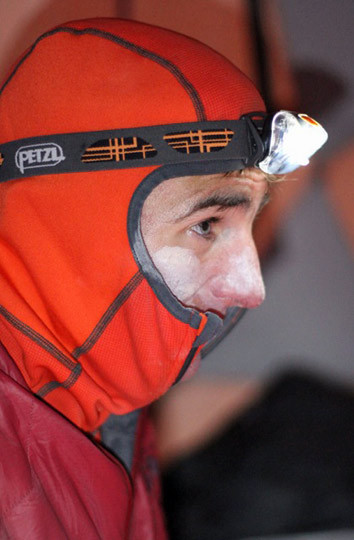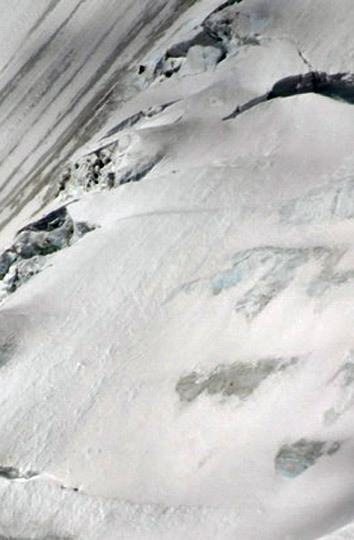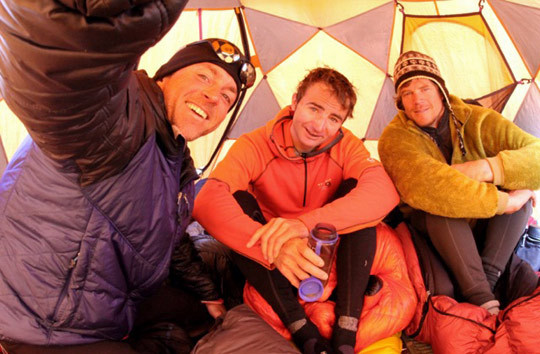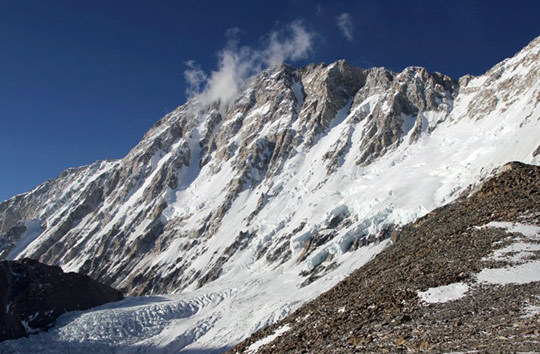
Ueli Steck after returning from his solo ascent of Shishapangma (8013m). Steck climbed the 2000m southwest face in 10.5 hours on April 17. [Photo] Rob Frost
Recently, Ueli Steck made a solo ascent of Shishapangma (8013m) in what may be the fastest time from base to summit in the mountain’s history. On April 17, Steck reached the top of the peak after 10.5 hours of climbing on the 2000m southwest face. He arrived back in base camp approximately 20 hours after his departure. Shishapangma, summited in 1964 by its northwest face, was the last 8000m peak see its first ascent, despite being the shortest. This climb is first of what Steck calls “Project: Himalaya,” his five-month expedition to speed-climb several of the 8000m giants.
Steck spent one month acclimatizing in the Khumbu Valley prior to the climb. He warmed up with American Freddie Wilkinson on Lobuche (6145m) on March 20, and the French Route of Cholatse (6440m) on March 27. Steck made the two-day trek to Shishapangma on April 10, and planned to climb with Canadian Don Bowie. Bowie, however, did not feel well acclimatized for the attempt. Because of calm, warm weather in the forecast, he encouraged Steck to continue with ascent alone.
Steck left camp at 10:30 p.m. on April 16, planning to climb to 7000 meters and descend. He said he had been hiking for 5 minutes when he heard “Hey Ueli! For sure you will need them!” Bowie called from base camp, holding up Steck’s down pants that he had forgotten. On the trail once again, Steck reached the bergschrund after 2.5 hours. He climbed a couloir of “perfect,” 55-degree snow and traversed to the British Route. Witnessing rockfall at 6800m had Steck second-guessing the conditions. He said he wondered what would happen during the day since the face was already warm and loose at midnight. He continued up a channel of snow, hoping it would take him to his target altitude of 7000m.

Ueli Steck descends from Shishapangma. “I regretted not having taken the same route down as I climbed up,” he wrote. [Photo] Rob Frost
Steck maintained his speed up through steep rock and intermittent ice until he climbed to 7200m. He had already reached his acclimatization goal, but felt confident and wanted to continue. “I promised my wife not to do any solos anymore. But this is not really a solo,” he wrote. “In this area a roped party would not really belay. You would loose too much time and it is not really necessary. I thought I could do it, and I could already see the exit.”
Steck gained a ridge and stashed most of his gear. He continued up the ridge to the summit, reaching the top at exactly noon. The descent to the saddle was “pure horror,” Steck said. “Here on the north side lies hip-deep powder snow. I regretted not having taken the same route down as I climbed up.” He continued down a couloir steep enough that he had to downclimb with his face to the snow. The angle eased off as he reached the glacier, which he said he crossed slowly and carefully. He arrived back at camp at 6:30 p.m., 20 hours after he began.
Steck’s first 8000m peak was Gasherbrum II (8035m), climbed in the spring of 2009. Next in the queue for “Project: Himalaya” is Cho Oyu (8201m), which Bowie and Steck plan to climb from the north aspect.
Read more about Steck’s speed-climbing philosophy in the March 7, 2011 Feature.

Ueli Steck, center, with Rob Frost and Don Bowie after descending from Shishapangma. Bowie had planned to climb with Steck, but did not feel well acclimatized. [Photo] Rob Frost
